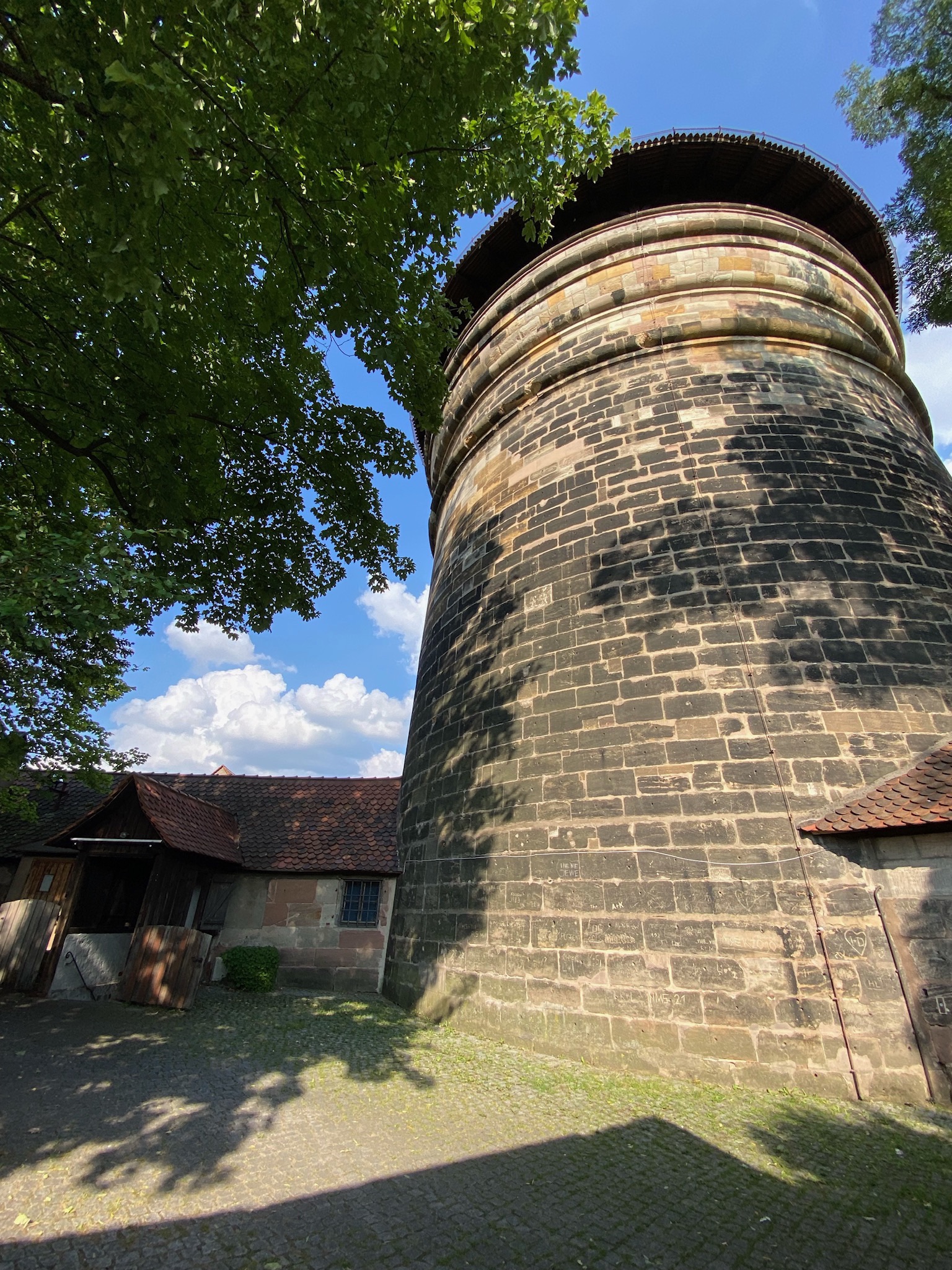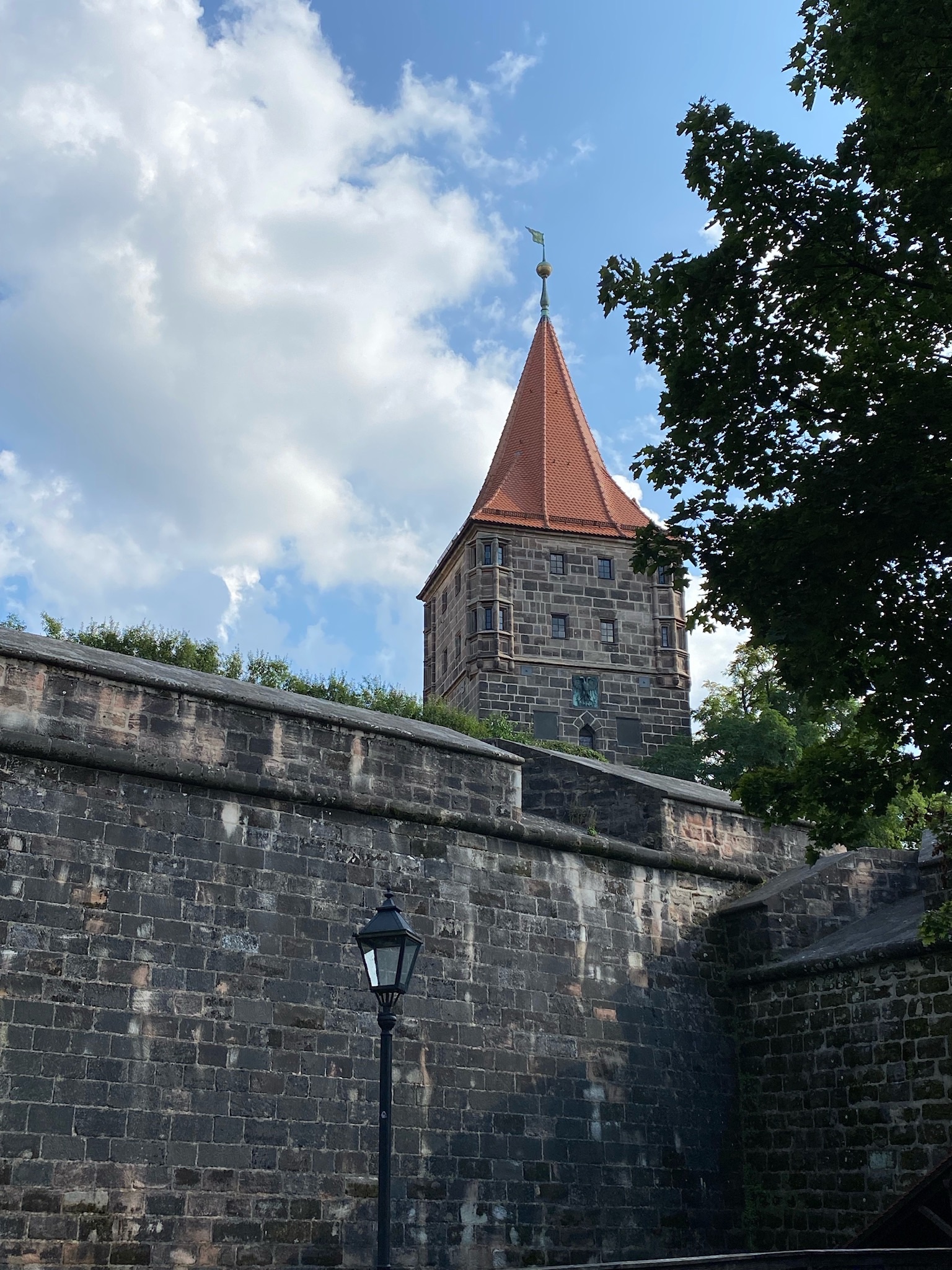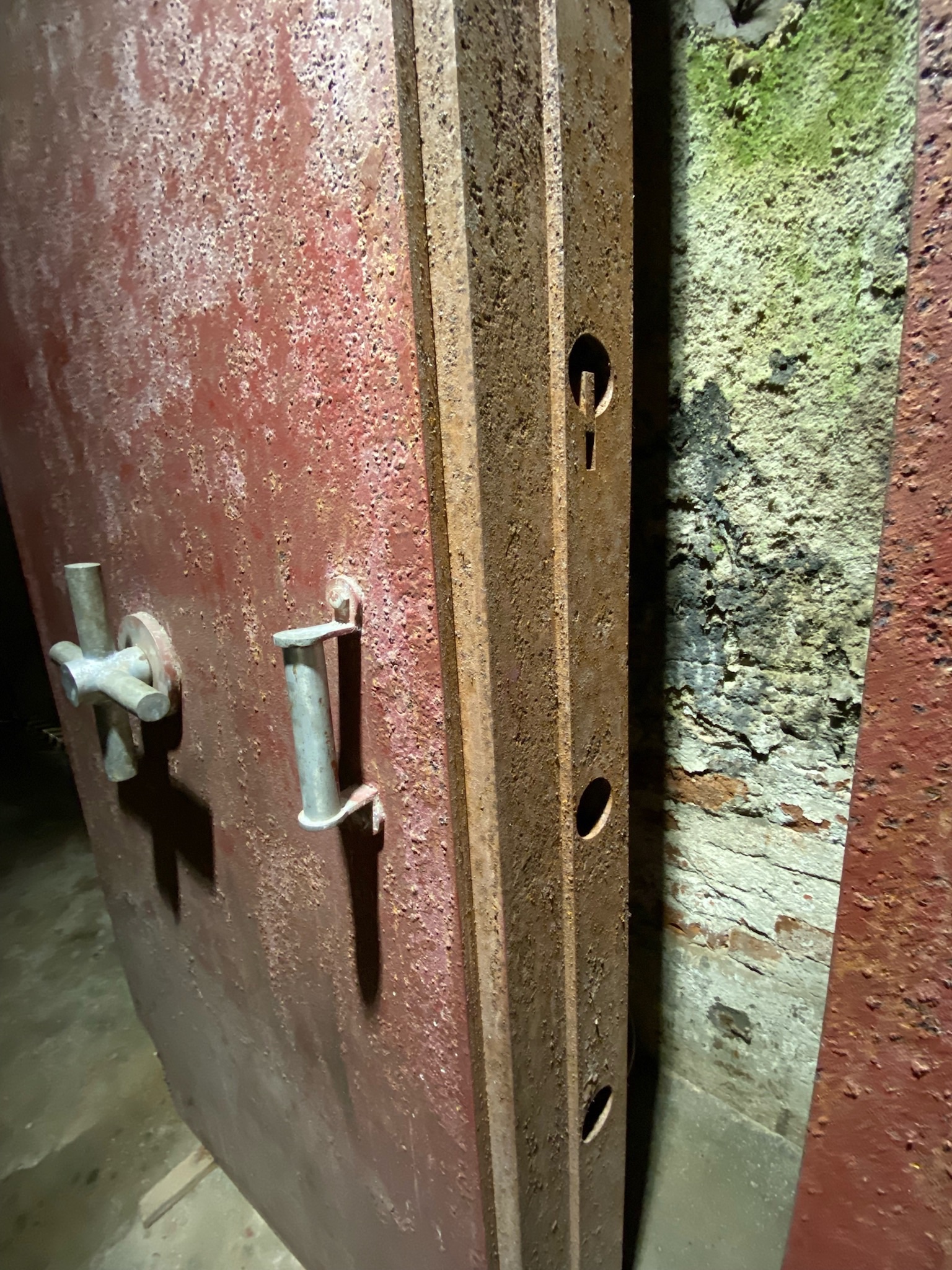12 September 2021

One reason for immediately liking Nuremberg is I love old walled cities. Nuremberg Castle and city walls represent a formidable medieval defensive system. During the Middle Ages, the castle was one of the most important imperial castles of the Holy Roman Empire. Today, refreshed and caffeine reinforced, I am ready for the climb to explore.
To reach the castle, I follow the city walls. Construction of the present wall started as early as the 12th century and ended officially in the 16th century. Not just the high stone wall but over 130 towers (today 71 remain), seven fortified gates, a flat field (kennel) of over 150′ then another smaller wall and the wide and 40′ deep moat though which water never flowed, protected the city and its inhabitants. Why so much?
This part of the continent, now known as Germany, was always under attack by invaders, sparring nobility, aggressive kings, emperors and popes who were constantly at war with someone else for some reason or another. From the Hussite Wars to the Thirty Years War, from early Germanic tribes, from the Ostrogoths, Lombards, Alemanni, and Vandals to Burgundians, Franks, and Visigoths, someone always seemed to be pounding at the gates.
The first fortifications are believed to date back to the 11th century. Originally each side of the Pegnitz River was walled but in the early 14c the two parts unified into one large walled fortification. The present wall was completed in 1400 and encompassed over three miles of city. Four gate towers were built at its four corner points. In 1452, construction of the moat was completed.

From 1500, the walls were redesigned for updated defensive needs. Old towers were rebuilt or demolished and new bastions built or refortified. The walls began with the entry and exit of the Pegnitz and ended at the wall north of the Frauentor which is where one enters the city from the train station. Gates and towers we’re added. Ultimately, towers included Laufer Tor, Frauentor, Spittlertor and Neutor plus two pedestrian passages at Hallertürlein and Wöhrder Türlein. Towers Tratzenzwinger and Fronveste secured the river’s entry and exit. There was also the Vestnertor which leads to the castle as does the entry at Sinwellturm.
Thankfully, the city walls have been almost completely preserved and continue to surround the old town of Nuremberg. Behind, on and in front of the wall and in the partially preserved kennel and moat, there are accessible walking paths and gardens. Some bastions are preserved as castle gardens. The gate towers directly below the castle, Tiergartnertor and Neutorturm, can be explored, as can the Frauentorturm, if open.
Nuremberg Castle is a complex of medieval buildings on a high sandstone ridge dominating the historical center of the city. I arrive at the entry under the imposing round tower of Sinwellturm. Ahead is a broad courtyard with Heidenturm (Heathens’ Tower), the main rooms of the Palas, Kaiserkapelle (Imperial Chapel), and Tiefer Brunnen (Deep Well) with Sinwellturm to my back.
In the Middle Ages, German kings and emperors (think King of the Romans and Holy Roman Emperors) did not have a capital, but journeyed with their numerous servants and royal court from one of their castles to the next. They needed lots of castles and protection. Nuremberg became a very important imperial castle, and in the following centuries, all German kings and emperors stayed here.

The complex is large but the castle itself is relatively small. The double Imperial Chapel is one of the oldest parts of the complex (c. 1200) with the royal chapel above the regular chapel and connected by an opening in the ceiling.

The Palas, or main building of the castle, has two floors which were used for official functions and as the Emperor’s residence. It was rebuilt and modified a number of times and now houses a permanent exhibition. The Palas is of late medieval/Renaissance with exceptional ceilings and wood paneling. The exhibits explain not only the working life of the castle, but also Nuremberg’s historical significance in the late Middle Ages and its place within the Holy Roman Empire. There are several excellent displays of edged weapons.
The Tiefer Brunnen or Deep Well is inside the small half-timbered house in the middle of the courtyard. It was the castle’s most important asset in times of siege as it provided access to water via its 164′ shaft. This was a major reason the castle was never breached. Although the first documented mention of the well dates from the 14th century, it is probably as old as the Imperial Castle itself.
Most of the other sites, like the 13th century Sinwellturm Tower (sinwell means perfectly round) are closed because of Covid restrictions. But one can stroll the compound, enjoy the panoramic views, and relax in the beautiful castle gardens below its walls.

Much history occurred in Nuremberg. Frederick II granted the Great Letter of Freedom to the city, including Imperial rights, and the privilege to mint coins and administer an independent customs policy, making the city an Imperial Free City subject only to the Emperor. The city of Nuremberg prospered and became one of the most important towns in Germany and it was here that The Golden Bull of 1356 named Nuremberg as the place of the first Imperial Diet of any newly elected ruler, quite an honor and powerful position. King Sigismund transferred a mandate to the Hohenzollern in 1411. (Sigismund of the famous Albrecht Dürer portrait at left.) Relations between the city and the nobles on castle hill eventually deteriorated leading to a burning of the castle. In 1422, Sigismund transferred the care of the Imperial Castle to the city, and in 1427, Frederick I sold the Castle to the city.
The Castle became less important. Emperors moved elsewhere where accommodations were more “imperial.” The last king holding his first Imperial Diet in Nuremberg was Maximilian I in 1491.
During the Thirty Years’ War in 1632, the armies of Gustavus Adolphus, King of Sweden, knocked on the gates, but were defeated less by weapons than by typhus and scurvy. I note this because I recently visited the Gustavus Adolphus College in St. Peter, Minnesota and know who he was. Gustavus got around. In 1806, French troops slept here, not sure if Napoleon did. And in World War II, the castle was damaged, with only the Chapel and the Sinwell Tower remaining intact. After the war, much of the castle was restored.
Which leads me to the next chapter of this rock and something the Nazis did right, if there was such a possibility. Had it not been for German advanced planning, sinister as it was, and the establishment of the Art Bunker buried deep within the rock at the base of the Nuremberg Castle, much irreplaceable German heritage and art would have been lost.

Historically, we can thank beer for the art’s survival. People didn’t know to boil water to make it safe to drink. Instead, their idea was to brew beer. Tasted better, too. Next, brewers needed a place to store their beer. What better way than in cellars and caves. When WW2 approached, Germany had ready-made locations for the storage and protection of their heritage.
As early as 1933 discussions had begun about how to protect German heritage from the bombs of war. War was in their future plan and so as early as 1939 the Nazis were transforming the beer cellars and caves into high tech underground art bunkers. With the installation of air conditioning, insulation, living quarters, running water and toilets, and massive iron doors, the Nazis planned for the removal of items they considered important to their German heritage. By the truck loads, it was moved into underground bunkers.
The plan was never to protect the people. At best, less than 5% of Nuremberg’s population could shelter in these caves. The Nazis ran a propaganda campaign warning of aerial attack; they just didn’t inform the people that art, books, altars, paintings, and imperial jewels were more important to save than their children. The entire plan was top secret.

There were many such bunkers around Nuremberg and Germany. Here, below the castle, were six chambers with individual temperature control behind massive iron doors, from 10 to 80 feet under solid rock. Shafts ran deep under the castle itself.
As the Monuments Men discovered, here was stored the priceless Our Lady of Krakow removed from Krakow and never intended to be returned. The Imperial and Holy Roman Empire regalia was also here as were paintings by homeboy Albrecht Dürer, the Angelic Salutation sculpture from St. Lorenz, the 500-year old mechanical clock and tableau adorning Frauenkirche and much, much more. What couldn’t be moved was encased in concrete, like the preserved Schöner Brunnen in the Hauptmarkt.
It took meticulous planning and in spite of Nazi motives, it worked. Much of this art would have been lost had it not been stored in these bunkers. On 2 Jan 1945, the RAF bombed Nuremberg, destroying almost 90% of the old city. And though art pieces were intended to be returned after the war, that was not true of everything. It was thanks to the Monuments Men that after the war several items were returned to their rightful locations, like Our Lady of Krakow.
The Art Bunker tour is fascinating, a must-do while in Nuremberg. Just dress warmly as the bunker is cold. The soldier appreciated working here only because he was safe from bombs.

Dining in Nuremberg is an adventure. There are hundreds of cafes and restaurants and at 7 they all seem full. When one finds an outside seat, the very first question is if I have reservations – meaning do I have full COVID verification. There is an assortment of ethnic restaurants from Thai, Vietnamese, Turkish, sushi, Indonesian, Italian and even simple German fare.
And this is a city where I can sit at a beautiful riverside cafe and spend hours enjoying dinner and a drink, listen to the river spilling over the rocks and contemplate a wonderful walled city.
Undisturbed
Watching the ducks.
Ducks? Okay, one more Duckomenta photo.

0 Comments